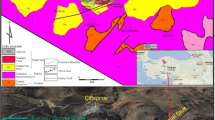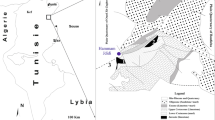Abstract
Active tufas in the form of waterfalls and dams occur along drainage channels in the Serra do André Lopes region (State of São Paulo, southeastern Brazil) and are associated with the karst system that developed on a dolomitic plateau with a superhumid subtropical climate. The predominance of autogenic waters enables the groundwater to become enriched in calcium carbonate, with low terrigenous sediment content. The tufas that were studied are composed of calcite and have high calcium contents and low magnesium contents. Eroded tufa beds that originate from changes in the position of fluvial channels or river flow rates also occur in this region. In the Sapatú deposit, phytohermal tufas with complex morphologies are arranged in levels constituting various temporally repeated sequences that were deposited between 10,570 and 4,972 cal years BP. In the Frias deposit, distal fluvial deposits of tufa are massive with a relatively greater quantity of terrigenous material and show evidence of dissolution and reprecipitation. The base of this deposit is composed of a cemented breccia dated at 25,390 years BP, which is younger than the overlying tufas (>42,000 years BP). In the two deposits, the levels of terrigenous sediments (quartz sand and lithic pebbles) and terrestrial gastropod shells are interpreted as phases of increased flow rate of rivers during intervals of higher rainfall.










Similar content being viewed by others
References
Alonso-Zarza AM, Tanner LH (2010) Carbonates in continental settings: facies, environments, and processes. Developments in Sedimentology, vol 61. Elsevier, Amsterdam, p 378
Andrews JE (2006) Palaeoclimatic records from stable isotopes in riverine tufas: synthesis and review. Earth Sci Rev 75:85–104
Arenas C, Gutiérrez F, Osácar C, Sancho C (2000) Sedimentology and geochemistry of fluvio-lacustrine tufa deposits controlled by evaporite solution subsidence in the central Ebro Depression, NE Spain. Sedimentology 47:883–909
Auler AS, Smart PL (2001) Late Quaternary Paleoclimate in Semiarid Northeastern Brazil from U-Series Dating of Travertine and Water-Table Speleothems. Quatern Res 55:159–167
Boch R, Spötl C, Reitner JM, Kramers J (2005) A Lateglacial travertine deposit in Eastern Tyrol (Austria). Austrian J Earth Sci 98:78–91
Boggiani PC, Coimbra AM (1995) Quaternary limestones of the Pantanal Area, Brazil. Anais da Academia Brasileira de Ciências 67:343–349
Boggiani PC, Coimbra AM, Gesicki AL, Sial AN, Ferreira VP, Ribeiro FB, Flexor JM (2002) Tufas Calcárias da Serra da Bodoquena, MS: cachoeiras petrificadas ao longo dos rios. In: Schobbenhaus C, Campos DA, Queiroz ET, Winge M, Berbert-Born M (eds) Sítios Geológicos e Paleontológicos do Brasil. DNPM, Brasília, pp 249–259
Campanha GAC (1991) Tectônica Proterozóica no Alto e Médio Vale do Ribeira, Estados de São Paulo e Paraná. Ph.D. thesis, Instituto de Geociências, Universidade de São Paulo, p 296
Campanha GAC (2002) O papel do sistema de zonas de cisalhamento transcorrentes na configuração da porção meridional da Faixa Ribeira. Habil. thesis, Instituto de Geociências, Universidade de São Paulo, p 105
Campanha GAC, Gimenez Filho A, Caetano SLV, Pires FA, Dantas ASL, Teixeira AL, Dehira LK (1985) Geologia das folhas Iporanga (SG-22-X-B-V-2) e Gruta do Diabo (SG-22-X-B-VI-1), Estado de São Paulo. PROMINÉRIO/IPT, Report 22352
Carthew KD, Taylor MP, Drysdale RN (2003) Are current models of tufa sedimentary environments applicable to tropical systems? A case study from the Gregory River. Sediment Geol 162:199–218
Corrêa D, Auler AS, Wang X, Edwards RL, Cheng H (2011) Geomorphology and genesis of the remarkable Araras Ridge tufa deposit, Western Brazil. Geomorphology 134:94–101
Cremaschi M, Zerboni A, Spötl C, Felletti F (2010) The calcareous tufa in the Tadrart Acacus Mt. (SW Fezzan, Libya): an early Holocene palaeoclimate archive in the central Sahara. Palaeogeogr Palaeoclimatol Palaeoecol 287:81–94
Duarte L, Vasconcelos MEC (1980a) Vegetais do Quaternário do Brasil. I- Flórula de Russas, CE. Anais da Academia Brasileira de Ciências 52:37–48
Duarte L, Vasconcelos MEC (1980b) Vegetais do Quaternário do Brasil. I- Flórula de Umbuzeiro, PB, CE. Anais da Academia Brasileira de Ciências 52:93–180
Flügel E (2004) Microfacies of carbonate rocks analysis, interpretation and application. Springer, Berlin, 976 p
Folk RL (1959) Practical petrographic classification of limestones. Bull Am Assoc Petrol Geol 43:1–38
Ford TD, Pedley HM (1996) A review of tufa and travertine deposits of the world. Earth-Sci Rev 41:117–175
Ford D, Williams P (1989) Karst geomorphology and hydrology. Chapman and Hall, London, p 601
Garnett ER, Andrews JE, Preece RC, Dennis PF (2004) Climatic change recorded by stable isotopes and trace elements in a British Holocene tufa. J Quat Sci 19:251–262
Genty D, Massault M, Gilmour M, Baker A, Verheyden S, Kepens E (1999) Calculation of past dead carbon proportion and variability by the comparison of AMS14C and TIMS U/Th ages on two Holocene stalagmites. Radiocarbon 41:251–270
Gradziński M (2010) Factors controlling growth of modern tufa: results of a field experiment. In: Pedley HM, Rogerson M (eds) Tufas and speleothems: unravelling the microbial and physical controls. Geological Society of London, London, pp 143–191
Griffiths HI, Pedley HM (1995) Did changes in the late last glacial and early Holocene atmosphere CO2 concentrations control the rates of tufa precipitation? Holocene 5:238–242
Hori M, Hoshino K, Okumura K, Kano A (2008) Seasonal patterns of carbon chemistry and isotopes in tufa depositing groundwaters of southwestern Japan. Geochim Cosmochim Acta 72:480–492
Horvatinčić N, Čalić R (2000) Interglacial Growth of Tufa in Croatia. Quatern Res 53:185–195
Horvatinčić N, Bronić IK, Obelić B (2003) Differences in the 14C age, δ13C and δ18O of Holocene tufa and speleothem in the Dinaric Karst. Palaeogeogr Palaeoclimatol Palaeoecol 193(1):139–157
Karmann I (1994) Evolução e dinâmica atual do sistema cárstico do alto Vale do Rio Ribeira de Iguape, sudeste do estado de São Paulo. Ph.D. thesis, Instituto de Geociências, Universidade de São Paulo, p 241
Karmann I, Sanchez LE (1986) Speleological Provinces in Brazil. In: International Union of Speleology, IX Congreso Internacional de Espeleologia, Barcelona, Anales, vol 1. pp 151–153
Leighton MW, Pendexter C (1962) Carbonate rock types. In: Ham WE (ed) Classification of carbonate rocks, vol 1. American Association of Petroleum Geologists, Tulsa, pp 33–61
Martín-Algarra A, Martín-Martín M, Andreo B, Julià R, González-Gómez C (2003) Sedimentary patterns in perched spring travertines near Granada (Spain) as indicators of the paleohydrological and paleoclimatological evolution of a karst massif. Sediment Geol 161:217–228
Martinet B, Sougy J (1961) Utilisation pratique des classications chimiques des roches carbonatées. Annales de la facultá dês sciences de l′Université de Dakar 6:81–92
McCormac FG, Hogg AG, Blackwell PG, Buck CE, Higham TFG, Reimer PJ (2004) SHCal04 Southern Hemisphere Calibration, 0–11.0 cal kyr BP. Radiocarbon 46:1087–1092
Pazdur A (2000) Radiocarbon in freshwater carbonates as tool of Late Quaternary studies. Geologos 5:135–154
Pazdur A, Pazdur MF, Starkel L, Szulc J (1988) Stable isotopes of Holocene calcareous tufa in southern Poland as paleoclimatic indicators. Quatern Res 30:177–189
Pedley HM (1990) Classification and environmental models of cool freshwater tufas. Sediment Geol 68:143–154
Pedley M (2009) Tufas and travertines of the Mediterranean region: a testing ground for freshwater carbonate concepts and developments. Sedimentology 56:221–246
Peña JL, Sancho C, Lozano MV (2000) Climatic and tectonic significance of Late Pleistocene and Holocene tufa deposits in the Mijares River canyon, eastern Iberian Range, northeast Spain. Earth Surf Proc Land 25:1403–1417
Pentecost A (1995) The Quaternary travertine deposits of Europe and Asia minor. Quaternary Science Reviews 14:1005–1028
Pentecost A (2005) Travertine. Springer, New York 445 p
Sallun Filho W, Karmann I, Sallun AEM, Suguio K (2009) Quaternary tufa in the Serra da Bodoquena karst, west-central Brazil: evidence of wet period. IOP Conf. Series: Earth and Environmental Science (Climate Change: Global Risks, Challenges and Decisions), vol 6. http://www.iop.org/EJ/article/1755-1315/6/7/072055/ees9_6_072055.pdf
Sallun Filho W, Almeida LHS, Torresi BF, Gouveia FRN, Person AL (2011) Caverna do Rio Fria (SP-40) revisitada 100 anos depois de Krone: história e geologia de uma caverna formada pelo crescimento de tufa. Espeleo-Tema (São Paulo) 22:7–23
Silva ATSF, Francisconi O, Godoy AM, Batolla F Jr (1981) Projeto integração e detalhe geológico no Vale do Ribeira, relatório final, integração geológica: Companhia de Pesquisas de Recursos Minerais (CPRM), Final report, p 205
Smith JR, Giegengack R, Schwarcz HP (2004) Constraints on Pleistocene pluvial climates through stable-isotope analysis of fossil-spring tufas and associated gastropods, Kharga Oasis, Egypt. Palaeogeogr Palaeoclimatol Palaeoecol 206:157–175
Talma AS, Vogel JC (1993) A simplified approach to calibrating C14 dates. Radiocarbon 35:317–322
Wang X, Auler AS, Edwards RL, Cheng H, Cristalli PS, Smart PL, Richards DA, Shen C (2004) Wet periods in northeastern Brazil over the past 210 kyr linked to distant climate anomalies. Nature 432:740–743
Zentmyer R, Myrow PM, Newell DL (2008) Travertine deposits from along the South Tibetan Fault System near Nyalam, Tibet. Geol Magazine 145:753–765
Acknowledgments
The authors thank the FAPESP for financially supporting this study (Proc. No 08/08583-7), the Caverna do Diabo State Park, especially Josenei Cara (Park Manager) and Josias Moreira (Environmental Monitor), for providing support, and Mr. Elerian and his employees from Fazenda Ribeirão do Fria for providing support in the field.
Author information
Authors and Affiliations
Corresponding author
Rights and permissions
About this article
Cite this article
Sallun Filho, W., Almeida, L.H.S., Boggiani, P.C. et al. Characterization of quaternary tufas in the Serra do André Lopes karst, southeastern Brazil. Carbonates Evaporites 27, 357–373 (2012). https://doi.org/10.1007/s13146-012-0118-1
Accepted:
Published:
Issue Date:
DOI: https://doi.org/10.1007/s13146-012-0118-1




